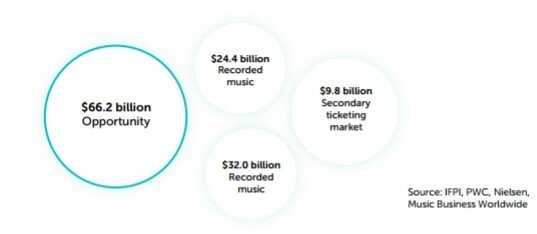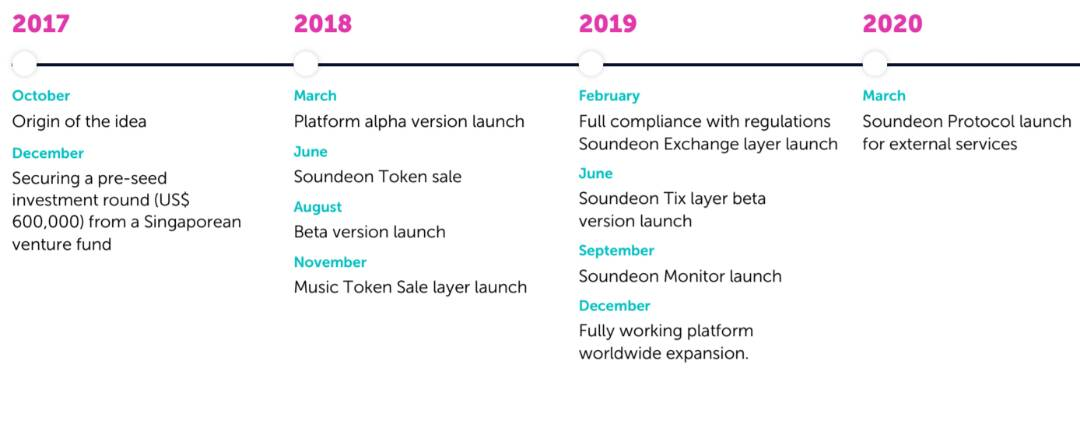SOUNDEON
- Get link
- X
- Other Apps
SOUNDEON — First Blockchain Music Platform

Soundeon is a decentralized and vertically integrated blockchain music platform.
MISSION
To discover new talent and empower creators to take control of their works by developing a blockchain-based digital media rights management and live ticketing environment that is uncensored, immutable, fair, transparent and fosters an ever-closer relationship between the artist and fan.
VISION
We envision a modern music industry that is revived with transparency and fair treatment that bridges the gap between the artist and fan. Where talent’s success relies on merit and creators can solely focus on creating.
PROBLEMS
The music industry is traditionally split between recorded and live music ticketing, each with their unique and inefcient practices nullified with the advent of the internet. Soundeon’s novel approach to resolving the hurdles faced by artists and fans on and ofine requires the blockchain platform to natively address these market frictions layer-by-layer. Hence below, we set forth to discuss the most pressing problems in recorded rights management and distribution, followed by, live event ticketing (otherwise known as touring). This section concludes with an explanation of the massive disconnect that exists between recorded and live music and the enormous value potential from using blockchain to integrate these traditionally segregated aspects of music industry.
Recorded Music
Recorded music dates back to the early 20th century with the advent of disruptive sound recording technologies. The industry as we know it today was formed in the 1960s as breakthrough communication technologies developed in World War II came to mass market. As music became big business, artist’s record and publishing contracts grew more convoluted. To this day in the United States, royalty contracts fall into two categories: income/profit sharing model is used in publishing agreements governing authorship rights and the per-unit royalty model adopted by record companies. After a decade in decline the $15.7 billion music market is undergoing a resurgence. However, much of this success has foregone the actual artists, as the Research Institute of the Finnish Economy put it: “royalty payments have moved from pennies-per-purchase to micro-pennies-per-stream.”

Music Publishing Agreements
Contemporary music publishing agreements contribute 65 to 85 percent of the aggregated net publishing income to the songwriter. Seemingly straight forward at first glance, and an improvement since the burdensome 50/50 profit split agreements that were common pre-1980. However, to this day the “cost deduction” clauses remain the favorite trade trick of publishing royalty sharks. Such clauses are infested with inflated or purely arbitrary terms which govern advances, administrative costs, and restrictions known in the music trade as “compulsory licenses” for mechanical rights that are set by the Copyright Royalty Board for song reproduction.
As of 2017, this license fee was set at 9.1 cents (or 1.75 cents per minute for songs exceeding 5 minutes) for each reproduction. Yet in practice, compulsory licenses are only used as pricing benchmarks for mechanical rights. Due to burdensome administrative provisions publishers find it easier (and often cheaper) to license their copyrights directly.
Labels often try to reduce publishing royalty obligations with various techniques, such as paying for mechanical licenses only on product sold rather than shipped (often with generous spoilage rates) or avoiding paying mechanical licenses altogether by for music sold through record clubs. Such techniques not only reduce the optimally intended paychecks to songwriters but also stall payments for many months.
Mechanicals: Collecting Internationally
Having shown in this brief overview how clustered with loopholes complicated publishing contracts are, this complication is compounded as we expand to other jurisdictions. For instance, United Kingdom has no compulsory licensing and only the first mechanical license is required (rightfully obtained with copyright owner’s permission). In the U.K., mechanical rights rates are a percentage of a records price (unlike in the U.S.) and are negotiated by the Mechanical Copyright Protection Society. MCPS collects 8.5% of the highest price paid by retailer for the record or 6.5% of retail excluding VAT. MCPS also categorizes licenses as AP1 or AP2 based on the creditworthiness of the licensee and this is where things get even more convoluted.
Across Europe, the Bureau International de l'Edition Mecanique (BIEM) negotiates rates on behalf of 55 societies across 59 countries (including EU members), charging 9.009% of PPD for mechanical rights. These jurisdictional variations are the bread and butter of mechanical rights collectors whose administrative fees vary from 5% to 20% of collections. Once the publisher collects their approximate 50% stake in mechanical royalties, and administrative fee is paid, the songwriter is left with peanuts.
Record Company Contracts
Over the past two decades, the mass adoption of the internet has transformed both, the way media is recorded and distributed. Not all media industries have embraced new opportunities arising from novel technologies to their fullest potential. Case in point, the $15.7 billion recorded music industry stumbles to shred their archaic, inefcient and convoluted practices and evolve into modernity.
Over a decade in market decline, consolidation and monopolization has aggravated the music industry’s competitiveness. Today the so called “major labels” or “Big Three” (Universal, Sony, Warner Brothers) control 68.7% of the industry. In turn, each of the “big three” own their distributor jointly known as “major distributors.” As with record labels, consolidation left only three “major distributors” one for each “major label.” This points to the extremely immense degree of supply chain control these incumbents can and do exhort. Major distributors distribute on behalf of their in-house labels, as well as major-distributed independent labels. Even independent distributors are owned by major labels (RED by Sony, ADA by Warner, etc.).
Marketing strategies intended to portray uniqueness and appeal to specific music genre fans coat the degree of to which the recorded music industry, by in large, constitutes a mass market factory line, controlled by an oligopoly.
Marketing strategies intended to portray uniqueness and appeal to specific music genre fans coat the degree of to which the recorded music industry, by in large, constitutes a mass market factory line, controlled by an oligopoly.
In part, this oligopoly was formed due to the high administrative and legal costs associated with running a label or distributor with global ambitions. More accurately these high costs are the consequence of market frictions within recorded music industry as a whole. The lack of transparency, trust and accountable data (as we’ve previously shown with publishing rights) within recorded music rights management not only allows but promotes for this extraordinary concentration of power in the hands of few.
Universal, Sony, Warner Brothers not only control nearly 70 percent of the label market, their oligopoly permeates the entire recorded music market. Let’s look at how harmful the status quo is.
SOLUTION
Soundeon is a decentralized blockchain-based musical and multimedia platform built on the Soundeon ecosystem – a protocol for the modern media. The Soundeon venture constitutes a consortium of blockchain experts, artists, software developers, intellectual property practitioners, and media executives that are already shacking up business as usual within the media industry.
Soundeon tackles foremost problems plaguing the performing arts industry with radical transparency, equitable ownership rights management, enhanced artists funding mechanisms and fair event ticketing.
We help artists regain control of their creations, monetize their talent and offer fans an ever-closer connection with their artists. As the music industry struggles to resolve the problems in digitally recorded music rights management and live event ticketing, Soundeon presents a layer-by-layer use-case approach.
At its core, novel technologies within blockchain computing such as self-executing smart contracts and immutable ledger technology enable Soundeon to create a functioning, stable, secure, and adaptive environment to solve practical problems in digital media and ticketing. The platform covers all aspects of the music industry.
From the creation and copyright of a work to contractual resale of both existing and future music assets, to concert organization and ticket sales.
From the creation and copyright of a work to contractual resale of both existing and future music assets, to concert organization and ticket sales.
Soundeon utilizes a multipronged approach to eliminating inefcient and archaic market practices adversely afecting both, the artists and their fans alike, on- and offline.
Through the native adoption of proprietary technology – the CSC (Creative Smart Contract ) Soundeon Protocol resolves earlier presented problems by developing the following initial application layers:
- Music Token Sale – An opportunity for artists to launch Token Sales and finance personal projects through the support of the Soundeon community.
- Soundeon Exchange – A tokenization tool and a decentralized exchange of
intellectual property where everyone can buy or sell their royalty income with an opportunity to create diversified personal music royalty portfolio. - Soundeon Tix – fan-centric blockchain-based smart ticketing platform is natively embedded on the Soundeon environment. Dynamic QR codes and Creative Smart Contracts eliminate ticket scalping, fraud and empower organizers to take full control of ticket resells both on primary and secondary markets.
- Soundeon Monitor – Royalty data aggregation from Soundeon and third-party providers, with integrated data analytics that covers all aspects of the artist’s creative output (including: copyright, royalty collection, ticket sales).
- Soundeon Player – A music player that utilizes blockchain technology for transparent royalty distribution.
TOKEN DETAILS
- Ethereum-based
ERC20
Unsold Tokens: Burned - Exchange Rate
1 Soundeon Token = 0.056923 USD - KYC / Whitelist: Yes
KYC/AML Provider: Sum & Substance - Total Token Supply 1.0 billion
no new tokens will ever be created - Soft cap: 52.7 million Tokens
- Hard cap: 650 million Tokens
Token Distribution

ROADMAP

TEAM

For more information, please visit:
Website: https://soundeon.com/en/
Whitepaper: https://soundeon.com/Soundeon_WP.pdf
Twitter: https://twitter.com/soundeoncom
Telegram: https://t.me/soundeon
Facebook : https://goo.gl/dwBqxr
Author: Crator Touch
My Bitcointalk Profile: https://bitcointalk.org/index.php?action=profile;u=1612381
My Ethereum Address: 0x4883E31Bb22ec89Dd8ddbf24C7F57C1317C58F7d
- Get link
- X
- Other Apps
Comments
Post a Comment